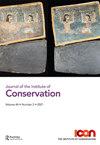Neela K.Wickremesinghe评论
IF 0.5
0 HUMANITIES, MULTIDISCIPLINARY
引用次数: 0
摘要
文化作者将这些作为初步数据报告,正如他们所提到的,更多的数据将支持他们的解释。最后两节包括与保护文化遗产有关的贡献,在实地保护和识别以前未知的考古遗址中使用地理信息系统技术,以及使用激光和核辐射方法作为促进文化遗产保护处理的工具。保加利亚亚姆波尔地区历史博物馆的Todor Valchev和Stefan Bakardzhiev在他们的论文“Boyadzhik特许区:GIS技术在文化遗产保护中的应用”中讨论了使用GIS来确定古代定居点的精确位置,在最后一节“遗产修复和保护方法”之前,来自保加利亚、罗马尼亚和法国的保护科学家同事发表了三篇关于保护的论文。保加利亚科学院固态物理研究所的Victoria Atanassova、Ivan Kostadinov、Peter Zahariev和Margarita Grozeva讨论了他们从石灰石样品中去除涂鸦喷漆的测试,花岗岩和大理石使用两种不同的激光系统,“激光辅助清除石头上的涂鸦:在文化遗产古迹修复中的潜在用途”。在“辐照文化遗产消毒”中,罗马尼亚国家物理与核工程研究与发展所的Corneliu Ponta提倡使用伽马辐射对有机遗产进行“消毒”,并支持将其作为保护遗产材料的安全方法,而Laurent Cortella(ARCNucléart-CEA Grenoble,法国)在“考古有机材料保存处理中的核技术以及在应用时如何将考古研究考虑在内”中描述了伽马辐射在浸水考古有机材料保护中的更广泛应用。本节中的所有论文都提供了有用的例子,将物理科学与最先进的方法相结合,为保护选择提供有用的选择,前提是有机会使用这些设施。这位评论家非常同意编辑们的观点,即东南欧“明显需要将受过传统训练的考古学家与对古代物质遗迹研究和保护感兴趣的自然科学专家更紧密地联系在一起”。需要召开此类会议及其出版的出版物,以便向国际科学观众传达当地的考古学。在这方面,这本书实现了出版的目标,因为这本书几乎涵盖了欧洲这一地区使用的遗产科学的所有方面,而开放获取这本书令人钦佩地推动了这一目标。这本书对所有从事巴尔干考古工作的人都很有用,因为这些论文包含了丰富的科学证据,有助于理解该地区的考古。尽管这本书没有包含太多关于创新仪器和方法的内容,但它是一本宝贵的科学研究和应用集,并向国际英语读者宣传了在巴尔干半岛开展的工作。总的来说,我觉得这本书读得很好,我学到了很多关于巴尔干考古的知识。这一领域的每一项工作都很重要。借用“每一点都有帮助”的说法,我发现每一个基于科学的案例研究——无论多么微小——都有助于构建过去生活的大局。巴尔干考古研讨会是一个有价值的科学系列会议,报告了巴尔干考古的发现,其会议记录值得一读,所以我非常期待2022年10月的会议!本文章由计算机程序翻译,如有差异,请以英文原文为准。
Neela K. Wickremesinghe reviews
culture; the authors report these as preliminary data, and as they mention, more data would support their interpretation. The last two sections include contributions related to the protection of cultural heritage, the use of GIS Technology in field conservation and for the identification of previously unknown archaeological sites, and the use of laser and nuclear irradiation methods as a tool to facilitate conservation treatment of cultural heritage objects. Todor Valchev and Stefan Bakardzhiev from the Regional Historical Museum in Yambol, Bulgaria, discuss the use of GIS to determine the precise location of ancient settlements in their paper ‘The Boyadzhik concession area: the use of GIS technology in the protection of cultural heritage’, before the last section, ‘Heritage Restoration and Conservation Methods’, which has three papers on conservation presented by conservation scientist colleagues from Bulgaria, Romania and France. Victoria Atanassova, Ivan Kostadinov, Peter Zahariev and Margarita Grozeva from the Institute of Solid State Physics, Bulgarian Academy of Sciences, discuss their testing for the removal of graffiti-paint sprays from samples of limestone, granite and marble using two different laser systems in ‘Laser-assisted removal of graffiti paint on stone: potential use in the restoration of cultural heritage monuments’. In ‘Cultural heritage disinfection by irradiation’, Corneliu Ponta from the National Institute for Research and Development in Physics and Nuclear Engineering in Romania promotes the use of gamma radiation to ‘disinfect’ organic heritage and supports it as a safe method for the conservation of heritage materials, while Laurent Cortella (ARCNucléart—CEA Grenoble, France) in ‘Nuclear techniques in preservation treatments of archaeological organic materials and how to take archaeological studies into account when applying them’ describes a wider range of applications of gamma irradiation for the conservation of waterlogged archaeological organic materials. All papers in this section offer useful examples where the physical sciences are combined with state-of-the-art methods to present useful options for conservation choices, provided that there is the opportunity to access such facilities. This reviewer could not agree more with the editors that South-Eastern Europe ‘is characterised by [...] an obvious need to bring closer together traditionally-trained archaeologists with specialists in natural sciences interested in the research and conservation of ancient material remains’. Meetings of this kind and their resulting publications are needed to communicate local archaeometry to an international scientific audience. In that respect, the book achieves the goal of publication, because the volume covers nearly all aspects of heritage sciences employed in this part of Europe andmaking the book open access admirably furthers this goal. The book is useful to everyone working on the archaeology of the Balkans, because the papers include a wealth of scientific evidence to facilitate understanding on the archaeology of the region. Although the book does not include much on innovative instrumentation nor methodologies, it is a valuable collection of scientific research and applications, and it promotes the work undertaken in the Balkans to an international, anglophone audience. Overall, I found this book a good read and I learnt a lot about the archaeology of the Balkans. Every work in this field is important. To borrow the homily ‘every little helps’, I found that every scientific-based case study helps—no matter how small— to build the bigger picture of life in the past. The Balkan Symposium on Archaeometry is a valuable scientific series of conferences which report findings on the archaeology of the Balkans, and their proceedings are worthwhile to read, so I very much look forward to the 2022 conference in October!
求助全文
通过发布文献求助,成功后即可免费获取论文全文。
去求助
来源期刊

Journal of the Institute of Conservation
HUMANITIES, MULTIDISCIPLINARY-
CiteScore
1.50
自引率
0.00%
发文量
22
期刊介绍:
The Journal of the Institute of Conservation is the peer reviewed publication of the Institute of Conservation (Icon). As such, its aims reflect those of Icon, to advance knowledge and education in conservation and achieve the long term preservation and conservation of moveable and immoveable cultural heritage. The Journal provides a collective identity for conservators; it promotes and supports both the profession and professionalism. With international contributions on all aspects of conservation, it is an invaluable resource for the heritage sector. The specific aims of the Journal are to: 1. promote research, knowledge and understanding of cultural heritage conservation through its history, practice and theory 2. provide an international forum to enable and disseminate advances in research, knowledge and understanding relating to conservation and heritage 3. champion and support professional standards of heritage conservation in the UK and internationally 4. provide a permanent record of issues relating to conservation and heritage 5. be financially and operationally sustainable. To achieve these aims, the Journal invites contributions from all those involved in the conservation of cultural heritage and related activities. Areas of interest include understanding cultural heritage materials and their degradation; subject reviews and histories of cultural heritage materials and conservation treatments; new, innovative or improved approaches to conservation and collections care theory, practice, communication, management and training; case studies demonstrating new, innovative or improved approaches; and conservation in its wider context. Submitters are encouraged to demonstrate how their work is of practical application to conservation. To maintain professional standards and promote academic rigour, submissions of articles and shorter notices are subject to an anonymous peer review process.
 求助内容:
求助内容: 应助结果提醒方式:
应助结果提醒方式:


